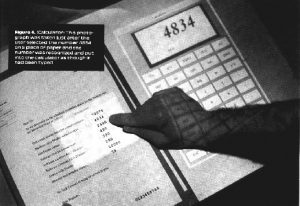It’s Tangible, It’s Embodied, But What Is It?
Tangible and Embodied Interaction (TEI)
What is tangible and embodied interaction? To me TEI, at its most basic form, is an alternative to the main stream interaction of data through a graphical user interface. A tangible interface allows the user to interact with digital data through physical actions. This is allowed as tangible interfaces are physically embodied, allowing the user to change data by moving physical artefacts or gestural actions. Tangible interaction moves away from the input/output paradigm of computing, as seen in graphical interfaces, by combining these concepts through physical embodiment.
The field emerged in 2002 with Brygg Ullmer’s PhD defence, where he outlined the field through his work on Tangible Bits (Ishii & Ullmer 1997) at MIT Media Lab. At this early stage Tangible Interaction looked at how physical interaction with the computer can be used as an alternative when working with data aggregates (Ullmer 2002) and modelling, such as Urp (Underkoffler & Ishii 1999). Classic examples of tangible interaction are mediaBlocks (Ullmer et al. 1998), and the Digital Desk (Wellner 1993). These are some of the most early works in the field but give examples of how tangible interaction breaks away from the standard desktop environment but hybridising the characteristics of digital and physical interaction (Dourish 2004). This is shown particularly well in the Digital Desk where the properties of paper meets hyper text and the convenience of electronic documents.

Theory and Philosophy in TEI
On the theme of theory and philosophy in TEI I have chosen three papers I find to be interesting. These range from practical to philosophy, looking the benefits of tangible interfaces in education, to the role of philosophical concepts in TEI.
The first paper I have chosen is Manches, O’Malley & Benford (2009)’s ‘Physical Manipulation: Evaluating the Potential for Tangible Designs’. Manches et al. looks at the effectiveness of tangible technologies as a resource for educating children. This is approached by first evaluating the benefits and disadvantages of physical manipulation of data. The examine how physical interaction allows children to develop their own strategies for completing numerical tasks, stemming from the children’s familiarity with physical objects and the freedom of constraints placed on children from GUI designers.
Secondly on this theme, van Dijk, van der Lugt & Hummels 2013’s ‘Beyond Distributed Representation’. van Dijk et al. explore the role of Embodied Cognition (EC) in TEI, looking at three different variation in TEI. The authors particularly focus on distributed representation and computation (DRC). On this theme they explore how tangible interfaces based on this variation of EC can reduce the cognitive load for the user through the context TEIs are placed in. van Dijk et al. note how contextual cues can provide cognitive scaffolding, shifting the centre of cognition from the user’s thought processes to the wider environment.
Lastly I have chosen a second paper by Hummels & van Dijk (2015) titled ‘Seven Principles to Design for Embodied Sensemaking’. This builds on an earlier critique (Dijk et al. 2013) of Radical Atoms (Ishii et al. 2012) claiming that Ishii’s new direction of TEI research is too Cartesian in nature. Hummels & van Dijk presents a framework of seven design guidelines for future TEI systems that follow a phenomenological standpoint rather than the Cartesian perspective pursued in Radical Atoms.
References
Dijk, J. V., Moussette, C., Kuenen, S. & Hummels, C. (2013), ‘Radical clashes: what tangible interaction is made of’, Tei 2013 pp. 323–326.
URL: http://dl.acm.org/citation.cfm?id=2460680
Dourish, P. (2004), Where the Action is: The Foundations of Embodied Interaction, MIT, London.
Hummels, C. & van Dijk, J. (2015), ‘Seven Principles to Design for Embodied Sensemaking’, Proceedings of the Ninth International Conference on Tangible, Embedded, and Embodied Interaction – TEI ’14 (figure 1), 21–28.
URL: http://dl.acm.org/citation.cfm?id=2677199.2680577
Ishii, H., Lakatos, D., Bonanni, L. & Labrune, J.-B. J. (2012), ‘Radical Atoms : Beyond Tangible Bits, Toward Transformable Materials’, Interactions XIX(February), 38–51.
URL: http://dl.acm.org/citation.cfm?id=2065337
Ishii, H. & Ullmer, B. (1997), ‘Tangible bits’, Proceedings of the SIGCHI conference on Human factors in computing systems CHI 97 39, 234–241.
URL: http://dl.acm.org/citation.cfm?id=258549.258715
Manches, A., O’Malley, C. & Benford, S. (2009), ‘Physical manipulation: evaluating the potential for tangible designs’, Proceedings of the 3rd International Conference on Tangible and Embedded Interaction – TEI ’09 pp. 77–84.
URL: http://portal.acm.org/citation.cfm?doid=1517664.1517688
Ullmer, B. (2002), Tangible Interfaces for Manipulating Aggregates of Digital Information, PhD thesis, MIT Media Laboratory.
URL: http://alumni.media.mit.edu/~ullmer/dissertation/
Ullmer, B., Ishii, H. & Glas, D. (1998), ‘mediaBlocks: physical containers, transports, and controls for online media’, Proc. SIGGRAPH98 32, 379–386.
URL: http://dl.acm.org/citation.cfm?id=280940
Underkoffler, J. & Ishii, H. (1999), ‘Urp: A luminous-tangible workbench for urban planning and design’, Proceedings of the SIGCHI conference on Human factors in computing systems: the CHI is the limit pp. 386–393.
URL: http://portal.acm.org/citation.cfm?id=303114
van Dijk, J., van der Lugt, R. & Hummels, C. (2013), ‘Beyond distributed representation’, Proceedings of the 8th International Conference on Tangible, Embedded and Embodied Interaction – TEI ’14 pp. 181–188.
URL: http://dl.acm.org/citation.cfm?id=2540930.2540934
Wellner, P. (1993), ‘Interacting with paper on the DigitalDesk’, Communications of the ACM 36(7), 87–96.
URL: http://portal.acm.org/citation.cfm?doid=159544.159630
Leave a Reply Cancel reply